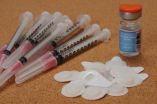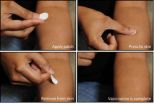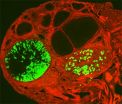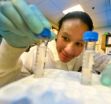(Press-News.org) The annual ritual of visiting a doctor's office or health clinic to receive a flu shot may soon be outdated, thanks to the findings of a new study published in the journal Vaccine.
The research, which involved nearly 100 people recruited in the metropolitan Atlanta area, found that test subjects could successfully apply a prototype vaccine patch to themselves. That suggests the self-administration of vaccines with microneedle patches may one day be feasible, potentially reducing administration costs and relieving an annual burden on health care professionals.
The study also suggested that the use of vaccine patches might increase the rate at which the population is vaccinated against influenza. After comparing simulated vaccine administration using a patch and by conventional injection, the percentage of test subjects who said they'd be vaccinated grew from 46 percent to 65 percent.
"Our dream is that each year there would be flu vaccine patches available in stores or sent by mail for people to self-administer," said Mark Prausnitz, a Regent's professor in the School of Chemical and Biomolecular Engineering at the Georgia Institute of Technology. "People could take them home and apply them to the whole family. We want to get more people vaccinated, and we want to relieve health care professionals from the burden of giving these millions of vaccinations."
The research on patient acceptance of vaccine patch immunization was published online February 11, 2014, by the journal Vaccine and will appear in a later edition of the print journal. In addition to Georgia Tech researchers, the project also included scientists from Emory University and the Centers for Disease Control and Prevention (CDC). Research into the use of microneedle patches for influenza vaccination has been supported by the National Institutes of Health (NIH).
The study is believed to be the first published report of a head-to-head comparison between microneedle patches and traditional intramuscular injection for the administration of vaccines in human subjects. The patches consisted of arrays of 50 microscopic needles about as tall as the thickness of a few hairs. When used for vaccination, the patches would be pressed painlessly onto a person's forearm to carry vaccine into the outer layers of skin, where they would prompt an immune reaction from the body.
The 91 study subjects, who had no previous experience with microneedle patches, were given brief instructions on applying the patches to themselves. Each volunteer applied three patches, had a fourth patch applied by a member of the research team, and received an injection of saline with a conventional hypodermic needle. Neither the patches nor the hypodermic needle actually carried a vaccine, and the study did not assess the efficacy of using microneedle patches for vaccinations in humans.
The researchers evaluated how well the volunteers were able to self-administer the microneedle patches. After the subjects pressed the patches into their skin, the researchers applied a dye to highlight the tiny holes made by the microneedles. By photographing the administration sites and counting the number of holes, they were able to assess the accuracy of the application.
"We found that everyone was capable of administering a microneedle patch appropriately, though not everyone did on the first try," Prausnitz said.
Some of the subjects used an applicator that made a clicking sound when sufficient force was applied to the patch. Use of that feedback device improved the ability of subjects to correctly apply patches and virtually eliminated administration mistakes.
During the study, the volunteers were asked if they planned to receive a flu vaccination in the next year and if their intent to be vaccinated would change if it could be done with the patch. The percentage saying they'd be vaccinated jumped from 46 to 65 percent when the patch was an option.
"If this holds for the population as a whole, that would have a tremendous impact on preventing disease and the cost associated with both influenza and the vaccination process," said Paula Frew, an assistant professor in the Emory University School of Medicine and a co-author of the study.
Interviewing the test subjects found strong support for self-administration of the flu vaccine.
"In addition to the preference for the vaccine patch, we found that a large majority of the people willing to be vaccinated would choose to self-administer the vaccine," said James Norman, the study's first author, who was a Georgia Tech graduate student when the research was conducted.
Study participants were asked to assess the pain associated with administering the patch and receiving the intramuscular injection. On a scale of one to 100, they rated the patches 1.5 on average, while the injection was rated 15.
Less than half the U.S. population receives vaccination against influenza each year. Several thousand Americans die of complications from the flu each year, and as many as 200,000 are hospitalized. Increasing the immunization rate could cut the deaths, hospitalizations and costs associated with the disease, Prausnitz noted.
Use of a vaccine patch could potentially also reduce the cost of vaccination programs. For influenza, the cost of storing and administering the vaccine – along with patient time to visit a clinic – accounts for as much as three-quarters of the total cost. If microneedle vaccine patches could be produced for about the same cost as current flu vaccines, self-administration could provide significant cost savings to the nation's health care system.
Animal studies have shown that microneedle patches are at least as good as conventional intramuscular injections at conferring immunity to influenza. Prausnitz and his research team plan to begin a Phase 1 clinical study of the vaccine patches in humans during the spring of 2015. If that study shows promise, it could lead to larger studies and development of commercial patch manufacture.
If all goes well, the vaccine patch could be available within five years. Prausnitz expects it to be administered first by health care professionals before being made available for self-administration.
INFORMATION:
In addition to those already named, the study also involved Martin I. Meltzer, senior health economist with the CDC, and two Georgia Tech researchers: Jaya M. Arya and Maxine A. McClain.
Mark Prausnitz is an inventor on patents that have been licensed to companies developing microneedle-based products, is a paid advisor to companies developing microneedle-based products, and is a founder/shareholder of companies developing microneedle-based products. This potential conflict of interest has been disclosed and is managed by Georgia Tech and Emory University.
Research on the use of microneedle patches for influenza vaccination has been supported by the National Institute of Biomedical Imaging and Bioengineering, part of the National Institutes of Health (NIH/NIBIB), under award R01EB006369. The content is solely the responsibility of the authors and does not necessarily represent the official views of the National Institutes of Health.
CITATION: James J. Norman, et al., "Microneedle Patches: Usability and Acceptability for Self-Vaccination Against Influenza," (Vaccine, 2014). (http://dx.doi.org/10.1016/j.vaccine.2014.01.076)
Self-administration of flu vaccine with a patch may be feasible, study suggests
2014-02-26
ELSE PRESS RELEASES FROM THIS DATE:
New blood analysis predicts risk of death
2014-02-26
The general state of a person's metabolism can be diversely illustrated with a new scientific blood analysis. With the aid of the analysis biomarkers predicting short-term mortality have now been discovered.
If a person belongs to a risk group based on these biomarker concentrations, he/she has a multifold risk of dying in the next five years compared to the general population. The study is based on blood samples of over 17,000 Finnish and Estonian people.
Mortality was related to four biomarkers in the blood: levels of two proteins (albumin and alpha-1 acidic glycoprotein), ...
Self-rated physical fitness in midlife an indicator of dementia risk
2014-02-26
How would you rate your own physical fitness? Is it good, satisfactory or maybe even poor? Surprisingly, your answer may reveal your future risk of getting dementia.
A recent collaborative study from Finland, involving the follow-up of 3,559 adults for 30 years, has found that a simple question about self-rated physical fitness in midlife may reveal individuals who are at an increased risk of developing dementia. Those who reported poor self-rated physical fitness in midlife, at the mean age of 50 years, were four times more likely to get dementia during the next three ...
Different eggs in adolescent girls and adult women
2014-02-26
Are the eggs produced by adolescent girls the same as the ones produced by adult women? A recent study published in Human Molecular Genetics by Professor Kui Liu from the University of Gothenburg in Sweden shows compelling evidence that there are two completely distinct types of eggs in the mammalian ovary – "the first wave" and "the adult wave".
Professor Liu's team used two genetically modified mouse models to show that the first wave of eggs, which starts immediately after birth, contributes to the onset of puberty and provides fertilizable eggs into the transition ...
Hormone therapy linked to better survival after lung cancer diagnosis in women
2014-02-26
DENVER – Survival among people with lung cancer has been better for women than men, and the findings of a recent study indicate that female hormones may be a factor in this difference. The combination of estrogen plus progesterone and the use of long-term hormone therapy were associated with the most significant improvements in survival.
The study was designed to explore the influence of several reproductive and hormonal factors on overall survival of women with non-small cell lung cancer (NSCLC). After adjusting for stage of disease at diagnosis, treatment type (surgery ...
Don't throw out old, sprouting garlic -- it has heart-healthy antioxidants
2014-02-26
"Sprouted" garlic — old garlic bulbs with bright green shoots emerging from the cloves — is considered to be past its prime and usually ends up in the garbage can. But scientists are reporting in ACS' Journal of Agricultural and Food Chemistry that this type of garlic has even more heart-healthy antioxidant activity than its fresher counterparts.
Jong-Sang Kim and colleagues note that people have used garlic for medicinal purposes for thousands of years. Today, people still celebrate its healthful benefits. Eating garlic or taking garlic supplements is touted as a natural ...
Better remote-sensing explosive detectors: The beginning of the end of full-body scanners?
2014-02-26
Standing in a full-body scanner at an airport isn't fun, and the process adds time and stress to a journey. It also raises privacy concerns. Researchers now report in ACS' The Journal of Physical Chemistry Letters a more precise and direct method for using that "terahertz" (THz) technology to detect explosives from greater distances. The advance could ultimately lead to detectors that survey a wider area of an airport without the need for full-body scanners.
R. Kosloff and colleagues explain that using THz spectroscopy by itself is challenging for sensing far-away explosives. ...
Caffeine-based gold compounds are potential tools in the fight against cancer
2014-02-26
The side effects of ingesting too much caffeine — restlessness, increased heart rate, having trouble sleeping — are well known, but recent research has shown that the stimulant also has a good side. It can kill cancer cells. Now, researchers report in the ACS journal Inorganic Chemistry that combining a caffeine-based compound with a small amount of gold could someday be used as an anticancer agent.
Angela Casini, Michel Picquet and colleagues note that caffeine and certain caffeine-based compounds have recently been in the spotlight as possible anticancer treatments. ...
MSU advances algae's viability as a biofuel
2014-02-26
EAST LANSING, Mich. — Lab success doesn't always translate to real-world success. A team of Michigan State University scientists, however, has invented a new technology that increases the odds of helping algae-based biofuels cross that gap and come closer to reality.
The current issue of Algal Research showcases the team's invention — the environmental photobioreactor. The ePBR system is the world's first standard algae growing platform, one that simulates dynamic natural environments.
Simply put, ePBR is a pond in a jar that helps identify, cultivate and test algal ...
Where have all the codfish gone?
2014-02-26
The mega-decline in cod and other fisheries across the North Atlantic Ocean threatens the livelihood of fishermen and communities in New England and Atlantic Canada. One suspect in the disappearance of cod and other groundfish is the food source for their young: a planktonic copepod crustacean, no larger than a grain of rice. Recent changes in local copepod populations have co-occurred with declines in fisheries elsewhere, such as the collapse of the cod fishery in Europe's North Sea.
For this and other reasons, Petra Lenz and Andrew Christie are among the scientists ...
Exercise, surgically removing belly fat improves cognition in obese, diabetic mice
2014-02-26
Augusta, Ga. – Cognitive decline that often accompanies obesity and diabetes can be reversed with regular exercise or surgical removal of belly fat, scientists report.
A drug already used to treat rheumatoid arthritis also helps obese/diabetic adult mice regain their ability to learn and comprehend, while transplanting belly fat to a normal mouse reduces those abilities, said Dr. Alexis M. Stranahan, neuroscientist at the Medical College of Georgia at Georgia Regents University.
Studies in humans and animals indicate that obesity and diabetes – which often go hand ...






